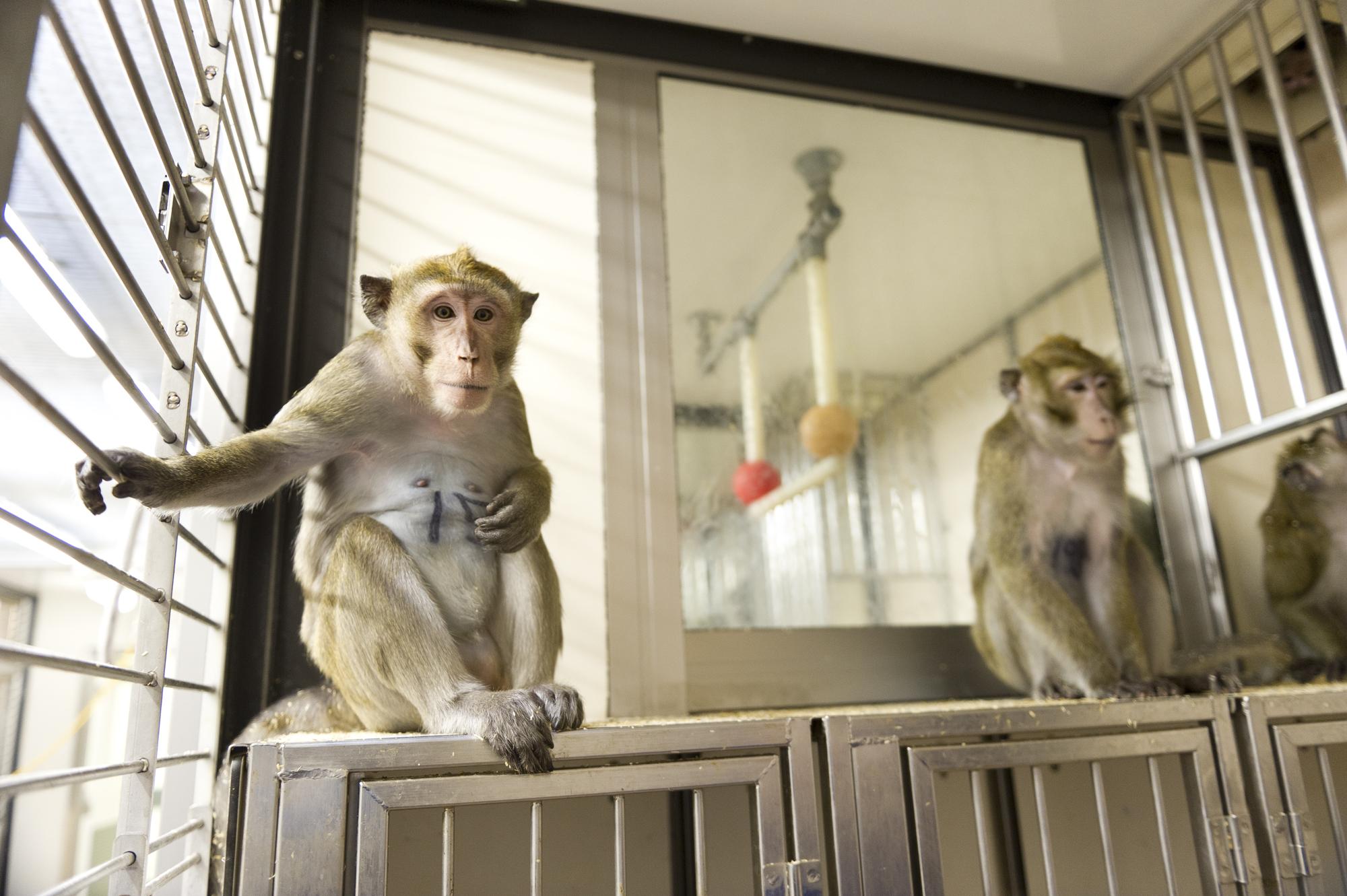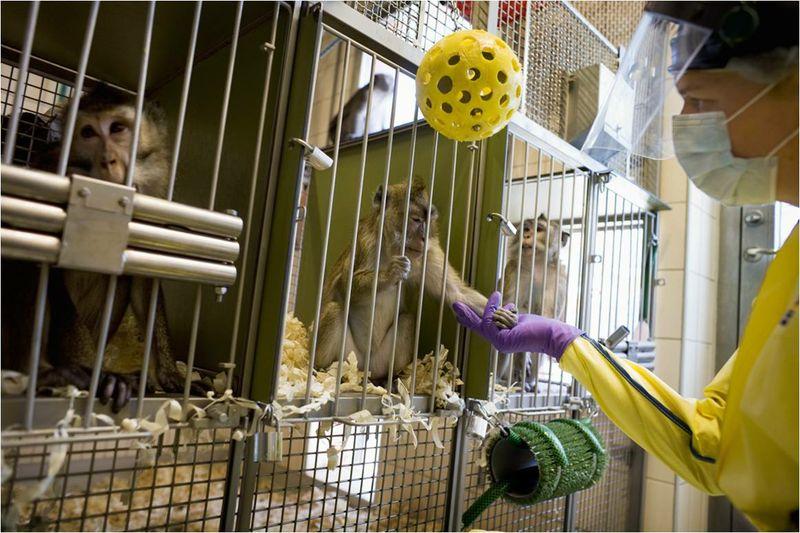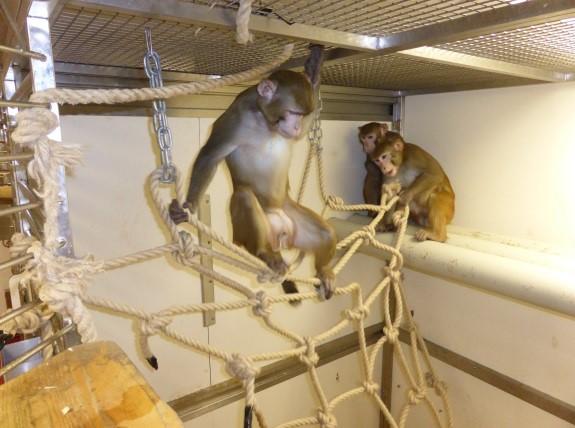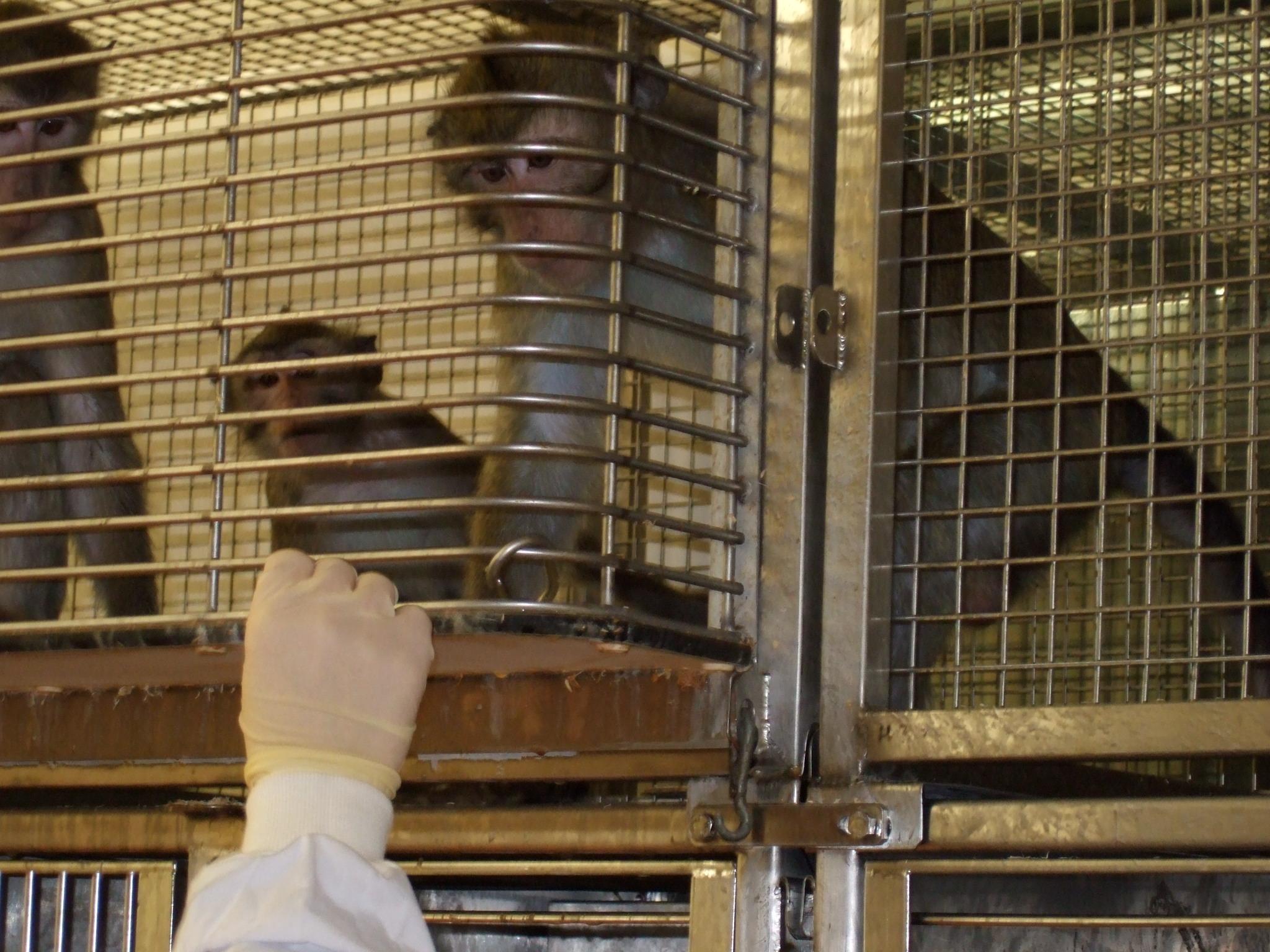Physiological parameters, such as heart rate, blood pressure, body temperature, serum levels of various stress hormones (e.g. cortisol) and immunological functions (e.g. suppression of lymphocyte activity) can be used to assess welfare [1-3]. Measurement of many of these parameters requires invasive monitoring techniques. However, where instrumentation, such as a heart rate transmitter, has already been implanted for experimental purposes, data that can help to assess welfare can be obtained with no additional adverse effects for the animal.
Values will fluctuate within ‘normal’ limits for any one animal. Extreme fluctuations are indicative of changes in welfare state [4]. Changes may occur due to environmental, husbandry or experimental events. In these cases, comparing measurements in individual animals before and after the event, or between ‘treated’ and ‘control’ animals, can help to infer whether welfare is affected [5]. Note there is often high variance between animals according to, for example, their age, sex, dominance status and the stability of the social group [5,6].
Although relative changes are often more informative than absolute values, it is possible to compare single values from individual animals with ‘normal’ ranges for the species published in the literature, or with colony records held by the institution. Reference values are given in tables: Haemodynamic, Respiratory and Haematology. ‘Normal’ parameter ranges can vary between institutions (e.g. due to the characteristics of the colony animals, and local practices for sample collection and analysis), so it is worthwhile to develop a baseline for your facility. The animals used to create this baseline should be in good physical condition (see Health indicators) and neither pregnant nor lactating (unless in a breeding facility).
Other sources of information include the APV Nonhuman Primate Formulary and Internet Primate Aging Database.
For a more extensive table, see: Extended table of haemodynamic parameters (NB link downloads an Excel sheet).
| Measurement | ParametersA | ParametersB |
|---|---|---|
| Heart rate | 95 – 235 bpm (mean weight 7.6 kg) | 120 – 180 bpm (rhesus and cynomolgus) |
| 125 – 240 bpm (mean weight 5.3 kg) | – | |
| Cardiac output | 500 – 3300 mL/min (mean weight 7.6 kg) | – |
| 350 – 1700 mL/min (mean weight 5.3 kg) | – | |
| Stroke volume | 4.7 – 16.7 mL (mean weight 7.6 kg) | – |
| 2.8 – 10.6 mL (mean weight 5.3 kg) | – | |
| Systolic artery pressure | 68 – 172 mm/Hg (mean weight 7.6 kg) | – |
| 122 – 194 mm/Hg (mean weight 5.3 kg) | – | |
| Diastolic artery pressure | 60 – 108 mm/Hg (mean weight 7.6 kg) | – |
| 81 – 121 mm/Hg (mean weight 5.3 kg) | – | |
| Arterial pH | 7.2 – 7.48 | 7.36 – 7.42 (rhesus) |
| Venous pH | 7.34 – 7.54 | – |
| Blood volume | 44.3 – 66.6 mL/kg | – |
| Plasma volume | 30 – 48.4 mL/kg | – |
| Extracellular fluid volume | 121 – 295 mL/kg | – |
| Total blood water | 628 – 721 mL/kg | – |
| Whole blood haemoglobin | 11.2 – 14.6 gm/100mL | 12 – 13.1 g/dl (rhesus) |
| – | 11 – 12.4 (cynomolgus) | |
| Haematocrit | 38 – 45% | 38.3 – 49.6 (rhesus) |
| – | 33.1 -37.5 (cynomolgus) | |
| Temperature | 37.8 – 39 oC | 38.7 -39.8 (rhesus) |
| – | 38.7 – 39.8 (cynomolgus) |
A Â Rhesus macaques: Max Planck Institute for Biological Cybernetics.
| Measurement | Parameters A |
|---|---|
| Dead space | 7 – 26 mL |
| Lung compliance | 9 – 27 mL/mmHg |
| Respiratory quotient | 76 – 78% |
| Tidal volume | 28 – 65 mL |
| Respiration rate | 27 – 56 1/min |
| Minute volume | 756 – 3640 mL/min |
| Arterial O2 saturation | 85 – 93% |
| Arterial O2 content | 14 – 18% volume |
| Arterial O2 tension | 65 – 94 mmHg |
| Arterial CO2 content | 50 – 67% volume |
| Arterial CO2 tension | 28 – 42 mmHg |
| Arterial-venous O2 difference | 4.5- 6% |
| O2 consumption | 55 – 85 mL/min (weight 3 – 4.5 kg) |
A: Rhesus macaques: Max Planck Institute for Biological Cybernetics.
Blood test values of macaques
(Reproduced from Tasker 2012)
| Measurement | ParametersA | ParametersB | ParametersC | ParametersD |
|---|---|---|---|---|
| White blood count (rhesus) | 6.828 x 106/L | 4.2 – 8.1 x 103/L (rhesus) | – | 11.9 x 106/µL |
| White blood count | – | 11 – 12.5 x 103/L (cynomolgus) | – | – |
| Red blood count | 5.511 x 103/L | 4.95 – 6.4 x106/L (rhesus) | 3.56 – 6.95 x 106/L | 6.5 x 106/L |
| White blood count | – | 5.3 – 6.3 x106/L (cynomolgus) | – | – |
| Haemoglobin | 12.589 g/dL | 71 – 75 fL (rhesus) | – | 12.22 g/dL |
| Mean corpuscular volume | 72.511 fL | 59 – 66 fL (cynomolgus) | – | – |
| Mean corpuscular haemoglobin | 22.878 pg | 22.8 – 24.5 pg (rhesus) | – | – |
| Mean corpuscular haemoglobin | – | 16.6 – 22.6 pg (cynomolgus) | – | – |
| Mean corpuscular haemoglobin concentration | 31.533% | 31 – 33.4 g/dL (rhesus) | – | – |
| Mean corpuscular haemoglobin concentration | – | 25.8 – 32.8 g/dL (cynomolgus) | – | – |
| Red blood cell distribution width | 12.857% | – | – | – |
| Haemoglobin distribution width | 1.93 g/dL | – | – | – |
| Platelet blood test | 290.78 x 103/L | – | – | – |
| Mean platelet volume | 9.714 fL | – | – | – |
| Platelet distribution width | 39.3% | – | – | – |
| Procalcitonin | 0.26% | – | – | – |
| Neutrophils | 56.22% | 26 – 52% (rhesus) | 5 – 88% | – |
| Neutrophils | – | 35 – 61% (cynomolgus) | – | – |
| Lymphocytes | 34.98% | 39 – 72% (rhesus) | 38-58% | – |
| Lymphocytes | – | 34 – 56% (cynomolgus) | – | – |
| Monocytes | 4.92% | 1 – 4% (rhesus) | 0 – 11% | 0.81 x 103/µ L |
| Monocytes | – | 0.4 – 3% (cynomolgus) | – | – |
| Eosinophils | 2.94% | 0 – 4% (rhesus and cynomolgus) | 0 – 14% | 0.34 x 103/µ L |
| Basophils | 0.2% | 0 – 0.4% (rhesus) | 0 – 6% | 0.034 x 103/µ L |
| Basophils | – | 0 – 0.2% (cynomolgus) | – | – |
| Large unstained cells | 0.744% | – | – | – |
| Lithium | 2.058 x 103/µ L | – | – | – |
| Mean peroxidase index | -13.878 x 103/µ L | – | – | – |
| White blood cell FLAGS | 4666.67 | – | – | – |
| Sodium | 146.33 mEq/L | 142 – 149 mEq/L (rhesus) | – | – |
| Sodium | – | 142 – 150 mEq/L (cynomolgus) | – | – |
| Potassium | 4.08 mEq/L | 3.3 – 3.7 mEq/L (rhesus) | – | – |
| Potassium | – | 3.3 – 3.9 mEq/L (cynomolgus) | – | – |
| Chloride | 107.17 mEq/L | 104 – 110 mEq/L (rhesus) | – | – |
| Chloride | – | 109 – 119 mEq/L (cynomolgus) | – | – |
| Glucose | 55 mg/dL | 38 – 89 mg/dL (rhesus) | 46 – 178 mg/dL | – |
| Glucose | – | 48 – 69 mg/dL (cynomolgus) | – | – |
| Phosphorous | 5.15 mg/dL | 1.4 – 6.4 mg/dL (rhesus) | – | – |
| Phosphorous | – | 3.8 – 5.4 mg/dL (cynomolgus) | – | – |
| Cholesterol | – | 122 – 154 mg/dL (rhesus) | 108 – 263 mg/dL | |
| Cholesterol | – | 106 – 148 mg/dL (cynomolgus) | – | – |
| Calcium | 9.6 mg/dL | 8.7 – 10.9 mg/dL (rhesus) | – | – |
| Calcium | – | 8.5 – 9.3 mg/dL (cynomolgus) | – | – |
| Platelets | – | 260 – 361 x 103/µl (rhesus) | 109 – 597 x 103/mm3 | 430 x 103/µl |
| Platelets | – | 300 – 512 x 103/µl (cynomolgus) | – | – |
| Magnesium | – | 1.38 – 1.6 mg/dL (rhesus) | – | – |
| Total protein | – | 6.4 – 7 g/dL (rhesus) | – | – |
| Total protein | – | 7.2 – 8 g/dL (cynomolgus) | – | – |
| Serum protein | – | – | 4.9 – 9.3 g/dL | – |
| Albumin | – | – | 2.8 – 5.2 g/dL | – |
| Globulin | – | – | 1.2 – 5.8 mg/dL | – |
| Blood urea nitrogen | – | – | 8 – 40 mg/dL | – |
| Total bilirubin | – | – | 0.1 – 2 mg/dL | – |
A Rhesus macaques: Max Planck Institute for Biological Cybernetics.
B Rhesus and cynomolgus macaques: Primate Products Inc..
C Wolfensohn & Honess (2005) Handbook of Primate Husbandry and Welfare.
D Cynomolgus macaques: Schurman and Smith (2005).
E Cynomolgus macaques: Tasker (2012).
Blood types of macaques
(Source: Primate Products Inc.)
| Blood type | Rhesus | Cynomolgus |
|---|---|---|
| A | Rare | Present |
| B | Common | Present |
| AB | Rare | Present |
| O | Likely present | Present |
Haematology and clinical chemistry parameters and their physiological function
(Reproduced from Tasker 2012)
Haematology
| Abbreviation | Parameter | Physiological function, uses and other considerations |
|---|---|---|
| HB | Haemoglobin concentration | Found in erythrocytes and carries oxygen. Helps to evaluate RBC mass [7]. Used as a measure of anaemia [8]. |
| RBC | Red blood cell count | Known as erythrocytes. Largest number of cells in the blood. Erythrocyte survival time is approximately 85 – 100 days in macaques. Effects on erythrocyte parameters typically reflect a change in the balance between RBC production and RBC loss. Changes in plasma volume through dehydration or volume expansion can indirectly affect erythrocyte parameters [8]. |
| PCV | Packed cell volume | Measure of percentage of red blood cells in a sample of spun whole blood. Used to estimate the degree of dehydration; the more dehydrated, the higher the PCV [7]. |
| RETA | Reticulocytes | Immature red blood cells. Develop and mature in bone marrow and circulate for a short period in blood before developing into mature red blood cells. Normal reticulocyte count is less than 1% in monkeys [7]. |
| RABS | Absolute reticulocytes | As above. |
| MCV | Mean cell volume | Measure of average red blood cell volume. MCV varies in cynomolgus monkeys depending on origin; larger in animals of Chinese/Vietnamese origin [7]. |
| MCH | Mean corpuscular haemoglobin | The average mass of hemoglobin per red blood cell in a sample of blood [9]. |
| MCHC | Mean cell haemoglobin concentration | Measure of the concentration of hemoglobin in a given volume of packed red blood cells. MCHC is lower in monkeys than other commonly used species in the laboratory [7]. |
| HDW | Haemoglobin distribution width | Measure of the heterogeneity of the red cell hemoglobin concentration. |
| RDW | Red cell distribution width | Measure of the variation of RBC width (volume). |
| PLT | Platelets | Known as thrombocytes, they are important for blood coagulation (clotting), as they stimulate vasoconstriction and fibrin formation. Decreased platelet count is associated with prolonged bleeding, e.g. from small wounds of venepuncture sites [7]. |
| PCT | Platelet distribution | – |
| MPV | Mean platelet volume | Measure of the average size of platelets found in blood. |
| PDW | Platelet distribution width | Measure of variation – an indication of variation in platelet size which can be a sign of active platelet release. |
| PT | Prothrombin time | Prothrombin is a pre-cursor for thrombin [9]. Prothrombin activator splits the enzyme thrombin from Prothrombin. Thrombin is essential for clotting. Small changes are considered not to be biologically meaningful [7]. |
| APTT | Activated partial thromboplastin time | A measure of coagulation mechanism by evaluating the intrinsic pathway. Responsible for converting prothrombin to thrombin, goes on to convert fibrinogen to fibrin. Small changes are considered not to be biologically meaningful [7]. |
| WBC | White blood cell count | Often termed leukocyte. Normally total white blood cell count is lower than RBC [9]. Important measure of immune function. Excited or frightened animals may have physiological leucocytosis (increased WBC count) due to endogenous catecholamine release, concurrently neutrophilia and lymphocytosis can occur. The quantitative determination of total and differential (see next row) WBC are included [7]. |
| N | Neutrophils | Most common WBC [9]. Granular leukocyte (granulocyte). Measure of immune function. Primary function is phagocytosis of small particles and integral to inflammation. Principal cell type found in peripheral blood. Stress-induced leukocyte response may include mature neutrophila (no immature neutrophils) [7]. |
| L | Lymphocytes | Second most common WBC [9] Non-granular leukocyte. Measure of immune function. Responsible for a wide variety of immune system functions. Principle cell type found in peripheral blood. Stress-induced leukocyte response may include lymphopenia (decreased numbers) [7]. |
| M | Monocytes | Non-granular leukocyte. Measure of immune function. Primary function is phagocytosis and ingestion of large particles, processes antigens and present them to lymphocytes in a more antigenic form. Usually only present in very low numbers. Stress-induced leukocyte response may include monocytosis [7]. |
| E | Eosinophils | Granulocyte. Measure of immune function. Stress-induced leukocyte response may include eosinopenia (decreased numbers). Present in low numbers [7]. |
| B | Basophils | Granulocyte. Usually only present in very low numbers [7]. Measure of immune function [9]. |
| LUC | Large unstained cells | Cells that have not taken up the stain during processing of blood and blood smears, therefore not red or white blood cells |
Clinical chemistry
| Abbreviation | Parameter | Physiological function, uses and other considerations |
|---|---|---|
| AST | Aspartate aminotransferase | AST in blood derived from heart (cardiac muscle) (predominantly), liver, skeletal muscle [9]. Used in conjunction with ALT to identify site of tissue damage [7]. |
| ALT | Alanine aminotransferase | ALT in blood derived from liver [9]. Highest activity in liver followed by cardiac muscle and kidney [10]. Can be high due to liver damage or liver cell damage may be markedly increased in animals that struggle during restraint thought to be through secondary iatrogenic muscle injury with handling or intramuscular injection of anaesthetic agents or sedative [7]. |
| ALP | Alkaline phosphatase | Measurement represents joint enzyme activity – may be higher in juvenile growing animals [10]. Fairly non-specific enzymes, widely distributed in tissues difficult to interpret changes [11]. |
| Gamma GT | Gammaglutamyltransferase | Highest concentrations found in the kidney, pancreas and liver [11]. Used as an indicator for cholestasis. |
| Na | Sodium | Electrolytes help to maintain fluid balance, pH, membrane potentials, muscular functions and nerve conduction etc. Sodium is the major cation in serum and the principal determinant of extracellular fluid volume [7]. |
| K | Potassium | Electrolytes help to maintain fluid balance, pH, membrane potentials, muscular functions and nerve conduction etc. Potassium is major intracellular cation, and is maintained in a narrow concentration range in serum, it is essential for muscle contraction [7]. |
| Cl | Chloride | Electrolytes help to maintain fluid balance, pH, membrane potentials, muscular functions and nerve conduction etc. |
| Ca | Calcium | Involved in neuromuscular activity, bone formation, coagulation [7]. |
| IN PHOS | Inorganic phosphorous | Essential for cell metabolism [9]. Similar functions to calcium, but more sensitive renal excretion and may serve as an indicator of renal function [12]. Levels vary with age; they are higher in very young animals. |
| T PROT | Total protein | Plasma proteins consist of Albumins and Globulins [9]. Total protein is a measure of all the different proteins in plasma. Involved in binding and transport of substances in the blood. Important for maintaining osmotic pressure and associated with immunity and disease resistance. Hyperproteinemia is associate with dehydration [7]. |
| ALB | Albumin | Most abundant plasma protein [9]. Functions include binding and transportation of substances, maintaining osmotic pressure and preventing large fluctuations in pH by acting as a buffer [13]. Plasma proteins including Albumin indicate synthetic activity of the liver. Cellular damage reduces protein synthesis and the levels of plasma proteins decreases reflecting chronic liver damage. |
| GLOB | Globulin | Heterogenic set of proteins with a number of functions (e.g. transport proteins, mediate inflammation, and immunoglobulins), important for immune function [7]. |
| AG RATIO | Albumin/globulin | Albumin/globulin After hepatocellular damage (e.g. liver damage) reduction in Albumin accompanied by a relative increase in gamma GT producing obvious effects on the albumin/globulin ratio [13]. |
| TOT CHOL | Total Cholesterol | Cholesterol is a precursor for steroid hormones [9]. Essential for cell membranes and a constituent of bile as it is required for the biosynthesis of bile acids. Endogenous it is produced by the liver [13]. Exogenous may be present in diet. Serum cholesterol is relatively stable [7]. Serum cholesterol and triglycerides may increase with age [10]. |
| GLUC | Glucose | Serum glucose reflects numerous factors; stress and excitement may produce significant elevations of serum glucose [10]. Hyperglycaemia may be due to stress or feeding the animal prior to venipuncture. The practice of fasting animals prior to venepuncture reportedly decreases the variability that accompanies post ingestion/digestion/intestinal absorption of glucose [7]. |
| UREA | Urea | Urea nitrogen principally used to assess renal function [10]. Urea nitrogen is formed in the liver. Urea and creatinine normally filtered from plasma by kidneys and therefore offers an indication of renal clearance [7]. |
| T BILI | Total bilirubin | Bilirubin is a breakdown product of heam from RBC destruction [9]. The liver is responsible for metabolising spent RBCs and conjugating haem [13] making it a useful as an indicator of liver damage [7]. |
| HCRE | Creatinine | Used as an indicator for renal function [10]. Formed in the muscle. Is a non-protein nitrogenous waste material [7]. Creatinine kinase activity is highest in the skeletal muscle, cardiac muscle and brain [10]. It may be markedly increased in animals that struggle during restraint [7] as a result of secondary iatrogenic muscle injury with handling or intramuscular injection of anaesthetic agents or sedatives. |
| TRIGS | Triglycerides | Fatty acid precursors, that have a large number of functions in the body e.g. in cell membranes [13]. |
References
- Line SW et al. (1989). Heart rate and activity of rhesus monkeys in response to routine events. Laboratory Primate Newsletter 28(2): 9-12.
- Reinhardt V et al. (1990). Cortisol response of female rhesus monkeys to venipuncture in homecage versus venipuncture in restraint apparatus. Journal of Medical Primatology 19(6): 601-6. https://doi.org/10.1111/j.1600-0684.1990.tb00467.x
-
Wolfensohn S and Honess P (2005). Handbook of primate husbandry and welfare, 1st edition. Wiley-Blackwell.
-
Tasker L. (2012). Linking welfare and quality of scientific output in cynomolgus macaques (macaca fascicularis) used for regulatory toxicology Stirling.
-
Kaplan JR et al. (1982). Social status, environment, and atherosclerosis in cynomolgus monkeys. Arteriosclerosis: An Official Journal of the American Heart Association, Inc 2(5): 359-68. https://doi.org/10.1161/01.ATV.2.5.359
-
Sapolsky RM (2004). Social status and health in humans and other animals. Annual Review of Anthropology 33: 393-418. https://doi.org/10.1146/annurev.anthro.33.070203.144000
-
Hall A and Everds C (2008). The use of laboratory animals in toxicology research. In: Principles and methods of toxicology (Ed., Hayes AW) (4th edition., pp. 48-102). Taylor & Francis.
-
Frandson RD and Spurgeon TL (1992). Anatomy and physiology of farm animals. Lea and Febiger.
-
Loeb WF and Quimby F (1989). The clinical chemistry of laboratory animals, 2nd edition. CRC Press. https://doi.org/10.1201/9781315155807
-
Evans GO (1996). Assessment of cardiotoxicity and myotoxicity. In: Animal clinical chemistry: A primer for toxicologists (Ed., Evans GO) (pp. 141-8). Taylor & Francis.
-
Evans GO (1996). Lipids. In: Animal clinical chemistry: A primer for toxicologists (Ed., Evans GO) (pp. 172-80). Taylor & Francis.
-
Stonard MD (1996). Assessment of neurotoxicity. In: Animal clinical chemistry: A primer for toxicologists (Ed., Evans GO) (pp. 149-56). Taylor & Francis.
-
Woodman DD (1996). Assessment of hepatotoxicity. In: Animal clinical chemistry: A primer for toxicologists (Ed., Evans GO) (pp. 66-82). Taylor & Francis.






